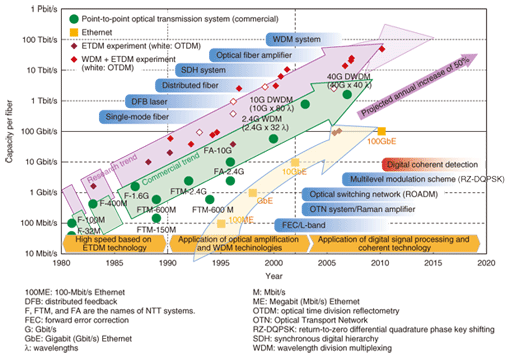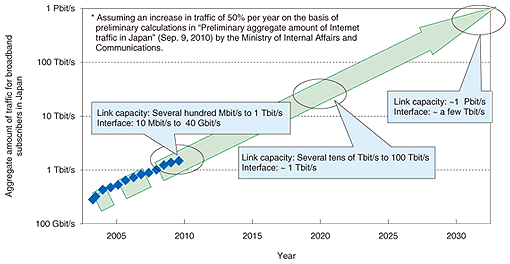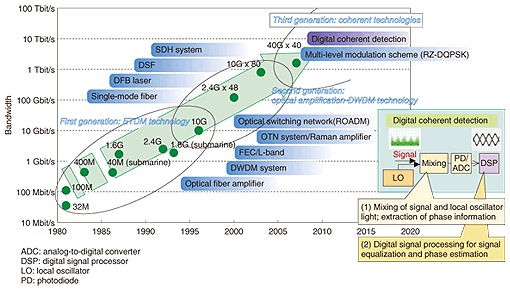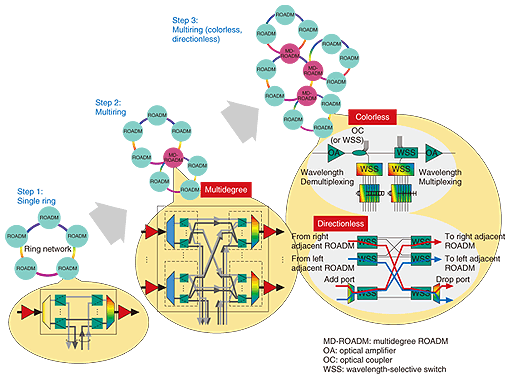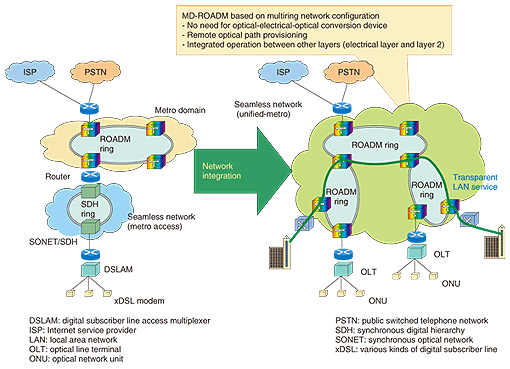 |
|||||||||||||||||||||||||||||||||||||||
|
|
|||||||||||||||||||||||||||||||||||||||
|
Feature Articles: Ultrahigh-speed Ultrahigh-capacity Optical Transport Network Vol. 9, No. 8, pp. 7–13, Aug. 2011. https://doi.org/10.53829/ntr201108fa1 Ultrahigh-speed Ultrahigh-capacity Transport Network Technology for Cost-effective Core and Metro NetworksAbstractThis article introduces cost-effective highly functional ultrahigh-speed ultrahigh-capacity optical transport network technologies that use optical paths to provide safe and secure diverse services cost-effectively.
1. IntroductionThe diffusion of the Internet, the penetration rate of mobile phones and smartphones, and all the services that utilize networks°Ĺsuch as video distribution services like YouTube, terrestrial digital television (TV), three-dimensional TV, online shopping, and e-government°Ĺhave exceeded expectations for communication network services and continue to grow. These types of broadband services are supported by terrestrial and wireless communication networks: fiber to the home (FTTH) has brought the optical era to peoples homes, with subscriber contracts in Japan exceeding 20 million as of March 2011, and LTE (Long Term Evolution) enables wireless communication speeds in excess of 70 Mbit/s (as of Dec. 2010). High-speed high-capacity transport technology has contributed greatly in the configuration of these communication networks by cost-effectively accommodating the vigorous 1.5-fold annual increase in traffic. The technological trends in transport technologies to date are shown in Fig. 1.
Transport networks are generally classified into three types: core networks connect major cities throughout the country, metro networks connect major areas within prefectures, and access networks provide connections to subscribers. In particular, there is a need to connect core and metro networks using high-speed signals, and we have constructed cost-effective transport networks based on cutting-edge optical transport network technology such as high-speed transmission technology. At present, there are cost-effective low-power consuming systems such as the 1.6-Tbit/s dense wavelength division multiplexer (DWDM)*1 transmission system [1] that multiplexes 40 wavelengths each carrying a 40-Gbit/s signal and the 800-Gbit/s (10 Gbit/s °Ŗ 80 wavelengths) reconfigurable optical add/drop multiplexer (ROADM)*2 transmission system that is used to construct 10-Gbit/s optical signal add/drop optical ring networks. However, as shown in Fig. 2, even these systems will have difficulty in the future in dealing with the boom in traffic volume, so even-more-cost-effective low-power-consuming optical transport network technology will be in demand. NTT Innovation Laboratories is vigorously pursuing the research and development (R&D) of optical transport networks with the goal of making cost-effective core and metro networks [2].
This article introduces the next-generation optical transport network technology, summarizing component technologies, discussing standardization trends, and clarifying R&D targets. It also introduces some future optical transport technologies for ten to twenty years ahead.
2. Latest technological trends in ultrahigh-speed high-capacity optical transportOptical technology has been part of communication networks for nearly thirty years, and during this time there have been striking advances in optical network technology such as a 104-times increase in transmission capacity and an over-106-times increase in the product of signal bandwidth and transmission distance, which are transmission technology indicators. There have been several important eras or generations for these pioneering technologies. The first generation focused on electrical time division multiplexing (ETDM)*3 technology, the second focused on optical amplification technology such as the erbium-doped fiber amplifier (EDFA)*4 and DWDM technology, and the third (current) generation focuses on coherent detection technology, which utilizes wave properties and is widely utilized in wireless networks (Fig. 3). In particular, the fusion of digital signal processing technology and coherent detection technology will be a primary approach to supporting optical communications in the future, and R&D of this is being eagerly promoted by major research organizations. This transport technology achieves a higher signal-to-noise ratio (SNR)*5 than existing technologies, uses multilevel modulation such as quadrature phase shift keying (QPSK)*6 in the optical phase, quadrature amplitude modulation (QAM)*7, and polarization-division multiplexing in ultrahigh-capacity transmission that has not been available up to now. Furthermore, the linear distortion created by chromatic dispersion and polarization-mode dispersion generated from optical fibers in the transmission path can be compensated for. Other major advantages are that it makes possible long-distance transmission and eliminates the need for the additional optical dispersion compensation fiber used for dispersion compensation between links; instead, compensation can be performed on the receiver side even when the transmission path is changed drastically. The NTT Science and Core Technology Laboratory Group, together with major domestic vendors, has conducted studies in a project supported by the Ministry of Internal Affairs and Communications to accelerate R&D of digital coherent technology in particular [3].
3. Optical transport network node technology and high-efficiency networkingWith the progress in digital coherent detection technology and other technologies, improved long-distance transmission of ultrahigh-speed signals is possible and as the optical domain widens, efficient design and operation at the optical level will become important. The progress in the optical transport network architecture is shown in Fig. 4. In the ring networks that form the foundation of the metro and core domains, the current ROADM transmission systems are mainly based on a single optical ring system. The expansion of the ROADM optical switch scale enables multiple rings to be connected at the optical level, and optical signal transmission without optical-electrical-optical regeneration can be achieved cost-effectively (Fig. 5). In addition, by devising optical switches such as wavelength selective switches, we can achieve colorless and directionless capabilities that remove the need for us to be concerned with color (wavelength). Optical networking enhancement at the optical level can be advanced as shown in Fig. 5.
Strengthening of the relationship between optical and electrical paths will become important in enhancing transport networking overall as the optical domain expands. There is demand for transport networks to be improved and diversified to handle datacenters that support ultrahigh-speed services in major metropolitan areas, ultrahigh-speed mobile backhaul for LTE etc., aggregation of low-to-medium-scale traffic in rural areas, and migration of the current telephone networks, etc. For this reason, by making appropriate use (integration between layers) of the three transport layers (i.e., the optical path layer incorporating multidirectional paths, the high-capacity electrical optical-channel data unit (ODU) path layer in the Optical Transport Network (OTN), and the MPLS-TP*8 (multiprotocol label switching transport profile) path layer), according to the network scale, we can expect to create highly cost-effective transport networks. Furthermore, the role of transport networking in future progress for the base network for cloud networking will be beneficial.
4. Role of standardization toward actualizing optical transport networksIn the progress of globalization in the field of optical communications, standardization for the global market is essential for the construction of cost-effective systems as well as for technological innovations. Standardization bodies such as ITU-T (International Telecommunication Union, Telecommunication Standardization Sector), IEEE, and OIF (Optical Internetworking Forum) need to discuss actively and popularize optical transport network technologies such as OTN technology, which efficiently conveys broadband services and various information data uniformly accommodated in optical channels, high-speed Ethernet technology that supports high-speed IP (Internet protocol) network services, and representative network control technologies such as GMPLS (generalized multiprotocol label switching)*9, which utilizes the network efficiently.
5. Future optical transport network technologyAt the practical stage, we currently have 10-Tbit/s-per-fiber-class systems utilizing 100-Gbit/s signal processing technology, but at the research level, studies on 100-Tbit/s/fiber-class systems are fruitful. In March 2010, a world record was established for 69.1-Tbit/s transmission per fiber using multilevel modulation and polarization multiplexing [4]. Within ten years, we may expect to see a practical 100-Tbit/s/fiber-class system utilizing existing optical fiber. However, to achieve even higher speeds and capacities, we will need innovative optical transport network technology to overcome the limitations on existing technologies, namely the s Shannon limit*10, noise figure limit, s shot noise limit*11, and power limits (both optical and electrical). The amount of power injected into a fiber should be limited for safe transmission in legacy optical fiber already installed around the world, so a total per-fiber capacity of more than 100 Tbit/s, in the case of long-distance transmission, is probably impossible to achieve for some time. Research on innovative forms of optical fiber, such as multimode fibers and multicore fibers in which the nonlinear effect can be controlled even when the optical input power is high, will accelerate [5] along with research on multiplexing and modulation technologies. On the other hand, in pursuit of a transport technology that can support the explosive growth in traffic demand, we are starting a new investigation initiative to fully utilize the efficiency of the optical spectral resources in optical fibers in transport networks. Until recently, the bandwidth of optical fiber was thought to be practically infinite, and the transmitted signal is allocated at specified locations (frequency grid). However, research has begun on an elastic optical path network [6] in which the required amount of optical spectral resources is assigned at the time they are needed. By using an s OFDM (orthogonal frequency division multiplexing)*12 bandwidth-variable transponder and a switch that flexibly modifies the bandwidth, we can assign the required and minimum optical spectral resources to transmit data and achieve much more cost-effective transport networks.
6. SummaryOptical transport networks should be significantly changed from existing telephone-based networks because of the rapid establishment of broadband service following the spread of the Internet and the appearance of high-speed mobile communications such as LTE. NTT is supporting these changes through digital coherent technology, which is representative of new optical transmission technologies, optical transparent network node technology of optical multiring systems, multilayer management control technology that extends over multiple layers, and the standardization needed for economization. Furthermore, transport networking will play a beneficial role in future advancement of the trunk network for cloud networking. This set of five Feature Articles introduces ultrahigh-speed ultrahigh-capacity optical transport network technologies that will lead to future cost-effective ultrahigh-capacity networks. The other four articles cover ultrahigh-capacity digital coherent optical transmission technology, optical transparent network node technology, highly efficient photonic networking technology, international standardization and implementation technology for optical transport networks, and future innovative optical transport network technology. We expect the development of these system technologies and photonic device technologies to lead to the construction of safer, more secure, and more pleasant communication networks. References
|
|||||||||||||||||||||||||||||||||||||||








